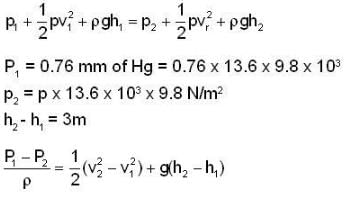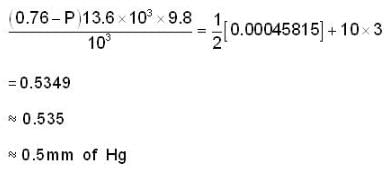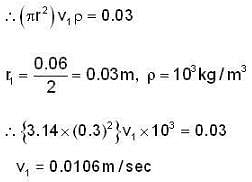Physics Exam > Physics Questions > A vertical tube has diameter 0.06 m at its bo...
Start Learning for Free
A vertical tube has diameter 0.06 m at its bottom end from which water flows out at the rate of 1.3 kg/minute. The pressure at the end is atmospheric pressure 0.9 mm of Hg. If the diameter of the tube is 0.04 m at a height of 3m from the bottom end. The pressure at that point is
Correct answer is '0.535'. Can you explain this answer?
| FREE This question is part of | Download PDF Attempt this Test |
Verified Answer
A vertical tube has diameter 0.06 m at its bottom end from which water...
Mass of water flowing in one second

Let V. be the velocity of flow of water at the bottom . then the mass of the water flowing per second =

Let v2 be the velocity of flow of water at the point where the radius of the tube is 0.02m. The mass of the water flowing per second is 0.03




Let V. be the velocity of flow of water at the bottom . then the mass of the water flowing per second =


Let v2 be the velocity of flow of water at the point where the radius of the tube is 0.02m. The mass of the water flowing per second is 0.03



Most Upvoted Answer
A vertical tube has diameter 0.06 m at its bottom end from which water...
Given data:
Diameter of the tube at the bottom end = 0.06 m
Rate of water flow = 1.3 kg/minute
Pressure at the end = 0.9 mm of Hg
Diameter of the tube at a height of 3 m = 0.04 m
We need to find the pressure at that point.
Assumptions:
1. The flow of water is steady.
2. The density of water remains constant throughout the tube.
3. The tube is vertical, so there is no change in height of the water column due to elevation.
Explanation:
Step 1: Convert units:
Convert the pressure at the end from mm of Hg to Pascal.
1 mm Hg = 133.3223684 Pascal
0.9 mm Hg = 0.9 * 133.3223684 Pascal = 119.99013156 Pascal
Step 2: Calculate the velocity of water at the bottom end:
Using the equation of continuity, we can relate the velocities and areas at different points in the tube.
A1v1 = A2v2
where A1 and A2 are the cross-sectional areas and v1 and v2 are the velocities at points 1 and 2, respectively.
Given:
Diameter at the bottom end = 0.06 m
Radius at the bottom end = 0.06/2 = 0.03 m
Area at the bottom end = πr1^2 = π(0.03)^2 = 0.00282743339 m^2
Rate of water flow = 1.3 kg/minute
Mass flow rate (m_dot) = 1.3 kg/minute = 1.3/60 kg/s
Density of water (ρ) = mass/volume = m_dot/(A1v1)
v1 = m_dot / (ρA1) = (1.3/60) / (1000 * 0.00282743339) = 0.07627118644 m/s
Step 3: Calculate the pressure at a height of 3 m:
Using the Bernoulli's equation between the bottom end and the point at 3 m,
P1 + ρgh1 + (1/2)ρv1^2 = P2 + ρgh2 + (1/2)ρv2^2
Since the tube is vertical, the velocity at the top end is zero, v2 = 0.
Also, h1 = 0 and h2 = 3 m.
P1 + (1/2)ρv1^2 = P2 + ρgh2
P2 = P1 + (1/2)ρv1^2 - ρgh2
Given:
P1 = 119.99013156 Pascal
ρ = 1000 kg/m^3 (density of water)
v1 = 0.07627118644 m/s
g = 9.8 m/s^2 (acceleration due to gravity)
h2 = 3 m
Substituting the values, we get:
P2 = 119.99013156 + (1/2)(1000)(0.07627118644^2
Diameter of the tube at the bottom end = 0.06 m
Rate of water flow = 1.3 kg/minute
Pressure at the end = 0.9 mm of Hg
Diameter of the tube at a height of 3 m = 0.04 m
We need to find the pressure at that point.
Assumptions:
1. The flow of water is steady.
2. The density of water remains constant throughout the tube.
3. The tube is vertical, so there is no change in height of the water column due to elevation.
Explanation:
Step 1: Convert units:
Convert the pressure at the end from mm of Hg to Pascal.
1 mm Hg = 133.3223684 Pascal
0.9 mm Hg = 0.9 * 133.3223684 Pascal = 119.99013156 Pascal
Step 2: Calculate the velocity of water at the bottom end:
Using the equation of continuity, we can relate the velocities and areas at different points in the tube.
A1v1 = A2v2
where A1 and A2 are the cross-sectional areas and v1 and v2 are the velocities at points 1 and 2, respectively.
Given:
Diameter at the bottom end = 0.06 m
Radius at the bottom end = 0.06/2 = 0.03 m
Area at the bottom end = πr1^2 = π(0.03)^2 = 0.00282743339 m^2
Rate of water flow = 1.3 kg/minute
Mass flow rate (m_dot) = 1.3 kg/minute = 1.3/60 kg/s
Density of water (ρ) = mass/volume = m_dot/(A1v1)
v1 = m_dot / (ρA1) = (1.3/60) / (1000 * 0.00282743339) = 0.07627118644 m/s
Step 3: Calculate the pressure at a height of 3 m:
Using the Bernoulli's equation between the bottom end and the point at 3 m,
P1 + ρgh1 + (1/2)ρv1^2 = P2 + ρgh2 + (1/2)ρv2^2
Since the tube is vertical, the velocity at the top end is zero, v2 = 0.
Also, h1 = 0 and h2 = 3 m.
P1 + (1/2)ρv1^2 = P2 + ρgh2
P2 = P1 + (1/2)ρv1^2 - ρgh2
Given:
P1 = 119.99013156 Pascal
ρ = 1000 kg/m^3 (density of water)
v1 = 0.07627118644 m/s
g = 9.8 m/s^2 (acceleration due to gravity)
h2 = 3 m
Substituting the values, we get:
P2 = 119.99013156 + (1/2)(1000)(0.07627118644^2
Free Test
FREE
| Start Free Test |
Community Answer
A vertical tube has diameter 0.06 m at its bottom end from which water...
Mass of water flowing in one second

Let V. be the velocity of flow of water at the bottom . then the mass of the water flowing per second =

Let v2 be the velocity of flow of water at the point where the radius of the tube is 0.02m. The mass of the water flowing per second is 0.03




Let V. be the velocity of flow of water at the bottom . then the mass of the water flowing per second =


Let v2 be the velocity of flow of water at the point where the radius of the tube is 0.02m. The mass of the water flowing per second is 0.03




|
Explore Courses for Physics exam
|

|
Similar Physics Doubts
A vertical tube has diameter 0.06 m at its bottom end from which water flows out at the rate of 1.3 kg/minute. The pressure at the end is atmospheric pressure 0.9 mm of Hg. If the diameter of the tube is 0.04 m at a height of 3m from the bottom end. The pressure at that point isCorrect answer is '0.535'. Can you explain this answer?
Question Description
A vertical tube has diameter 0.06 m at its bottom end from which water flows out at the rate of 1.3 kg/minute. The pressure at the end is atmospheric pressure 0.9 mm of Hg. If the diameter of the tube is 0.04 m at a height of 3m from the bottom end. The pressure at that point isCorrect answer is '0.535'. Can you explain this answer? for Physics 2024 is part of Physics preparation. The Question and answers have been prepared according to the Physics exam syllabus. Information about A vertical tube has diameter 0.06 m at its bottom end from which water flows out at the rate of 1.3 kg/minute. The pressure at the end is atmospheric pressure 0.9 mm of Hg. If the diameter of the tube is 0.04 m at a height of 3m from the bottom end. The pressure at that point isCorrect answer is '0.535'. Can you explain this answer? covers all topics & solutions for Physics 2024 Exam. Find important definitions, questions, meanings, examples, exercises and tests below for A vertical tube has diameter 0.06 m at its bottom end from which water flows out at the rate of 1.3 kg/minute. The pressure at the end is atmospheric pressure 0.9 mm of Hg. If the diameter of the tube is 0.04 m at a height of 3m from the bottom end. The pressure at that point isCorrect answer is '0.535'. Can you explain this answer?.
A vertical tube has diameter 0.06 m at its bottom end from which water flows out at the rate of 1.3 kg/minute. The pressure at the end is atmospheric pressure 0.9 mm of Hg. If the diameter of the tube is 0.04 m at a height of 3m from the bottom end. The pressure at that point isCorrect answer is '0.535'. Can you explain this answer? for Physics 2024 is part of Physics preparation. The Question and answers have been prepared according to the Physics exam syllabus. Information about A vertical tube has diameter 0.06 m at its bottom end from which water flows out at the rate of 1.3 kg/minute. The pressure at the end is atmospheric pressure 0.9 mm of Hg. If the diameter of the tube is 0.04 m at a height of 3m from the bottom end. The pressure at that point isCorrect answer is '0.535'. Can you explain this answer? covers all topics & solutions for Physics 2024 Exam. Find important definitions, questions, meanings, examples, exercises and tests below for A vertical tube has diameter 0.06 m at its bottom end from which water flows out at the rate of 1.3 kg/minute. The pressure at the end is atmospheric pressure 0.9 mm of Hg. If the diameter of the tube is 0.04 m at a height of 3m from the bottom end. The pressure at that point isCorrect answer is '0.535'. Can you explain this answer?.
Solutions for A vertical tube has diameter 0.06 m at its bottom end from which water flows out at the rate of 1.3 kg/minute. The pressure at the end is atmospheric pressure 0.9 mm of Hg. If the diameter of the tube is 0.04 m at a height of 3m from the bottom end. The pressure at that point isCorrect answer is '0.535'. Can you explain this answer? in English & in Hindi are available as part of our courses for Physics.
Download more important topics, notes, lectures and mock test series for Physics Exam by signing up for free.
Here you can find the meaning of A vertical tube has diameter 0.06 m at its bottom end from which water flows out at the rate of 1.3 kg/minute. The pressure at the end is atmospheric pressure 0.9 mm of Hg. If the diameter of the tube is 0.04 m at a height of 3m from the bottom end. The pressure at that point isCorrect answer is '0.535'. Can you explain this answer? defined & explained in the simplest way possible. Besides giving the explanation of
A vertical tube has diameter 0.06 m at its bottom end from which water flows out at the rate of 1.3 kg/minute. The pressure at the end is atmospheric pressure 0.9 mm of Hg. If the diameter of the tube is 0.04 m at a height of 3m from the bottom end. The pressure at that point isCorrect answer is '0.535'. Can you explain this answer?, a detailed solution for A vertical tube has diameter 0.06 m at its bottom end from which water flows out at the rate of 1.3 kg/minute. The pressure at the end is atmospheric pressure 0.9 mm of Hg. If the diameter of the tube is 0.04 m at a height of 3m from the bottom end. The pressure at that point isCorrect answer is '0.535'. Can you explain this answer? has been provided alongside types of A vertical tube has diameter 0.06 m at its bottom end from which water flows out at the rate of 1.3 kg/minute. The pressure at the end is atmospheric pressure 0.9 mm of Hg. If the diameter of the tube is 0.04 m at a height of 3m from the bottom end. The pressure at that point isCorrect answer is '0.535'. Can you explain this answer? theory, EduRev gives you an
ample number of questions to practice A vertical tube has diameter 0.06 m at its bottom end from which water flows out at the rate of 1.3 kg/minute. The pressure at the end is atmospheric pressure 0.9 mm of Hg. If the diameter of the tube is 0.04 m at a height of 3m from the bottom end. The pressure at that point isCorrect answer is '0.535'. Can you explain this answer? tests, examples and also practice Physics tests.

|
Explore Courses for Physics exam
|

|
Suggested Free Tests
Signup for Free!
Signup to see your scores go up within 7 days! Learn & Practice with 1000+ FREE Notes, Videos & Tests.


















